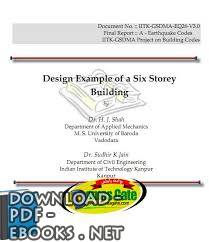📘 قراءة كتاب تصميم بناية 6 طابق أونلاين


تصميم بناية 6 طابق
IITK-GSDMA-EQ26-V3.0 Page 3
Example — Seismic Analysis and Design of a Six Storey Building
Problem Statement:
A six storey building for a commercial complex has plan dimensions as shown in Figure 1. The building is
located in seismic zone III on a site with medium soil. Design the building for seismic loads as per IS 1893
(Part 1): 2002.
General
1. The example building consists of the main
block and a service block connected by
expansion joint and is therefore structurally
separated (Figure 1). Analysis and design for
main block is to be performed.
2 The building will be used for exhibitions, as an
art gallery or show room, etc., so that there are
no walls inside the building. Only external
walls 230 mm thick with 12 mm plaster on
both sides are considered. For simplicity in
analysis, no balconies are used in the building.
3. At ground floor, slabs are not provided and the
floor will directly rest on ground. Therefore,
only ground beams passing through columns
are provided as tie beams. The floor beams are
thus absent in the ground floor.
4. Secondary floor beams are so arranged that
they act as simply supported beams and that
maximum number of main beams get flanged
beam effect.
5. The main beams rest centrally on columns to
avoid local eccentricity.
6. For all structural elements, M25 grade concrete
will be used. However, higher M30 grade
concrete is used for central columns up to
plinth, in ground floor and in the first floor.
7. Sizes of all columns in upper floors are kept the
same; however, for columns up to plinth, sizes
are increased.
8. The floor diaphragms are assumed to be rigid.
9. Centre-line dimensions are followed for
analysis and design. In practice, it is advisable
to consider finite size joint width.
10. Preliminary sizes of structural components are
assumed by experience.
11. For analysis purpose, the beams are assumed
to be rectangular so as to distribute slightly
larger moment in columns. In practice a beam
that fulfils requirement of flanged section in
design, behaves in between a rectangular and a
flanged section for moment distribution.
12. In Figure 1(b), tie is shown connecting the
footings. This is optional in zones II and III;
however, it is mandatory in zones IV and V.
13. Seismic loads will be considered acting in the
horizontal direction (along either of the two
principal directions) and not along the vertical
direction, since it is not considered to be
significant.
14. All dimensions are in mm, unless specified
otherwise
تحميل كتاب بدون روابط مباشر تصميم بناية 6 طابق
قراءة وتصفح أولاين كتاب تصميم بناية 6 طابق
تأليف: egyptsystem
نوع الكتاب : zip.
عداد القراءة:
اذا اعجبك الكتاب فضلاً اضغط على أعجبني و يمكنك تحميله من هنا:

شكرًا لمساهمتكم
شكراً لمساهمتكم معنا في الإرتقاء بمستوى المكتبة ، يمكنكم االتبليغ عن اخطاء او سوء اختيار للكتب وتصنيفها ومحتواها ، أو كتاب يُمنع نشره ، او محمي بحقوق طبع ونشر ، فضلاً قم بالتبليغ عن الكتاب المُخالف:
 قبل تحميل الكتاب ..
قبل تحميل الكتاب ..
يجب ان يتوفر لديكم برنامج تشغيل وقراءة ملفات pdf
يمكن تحميلة من هنا 'http://get.adobe.com/reader/'


 منصّة المكتبة
منصّة المكتبة 